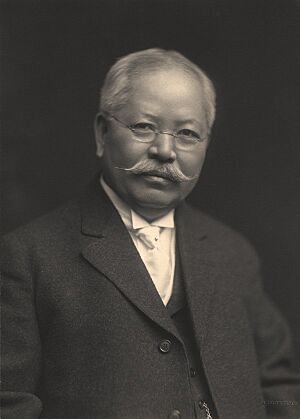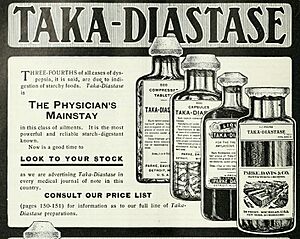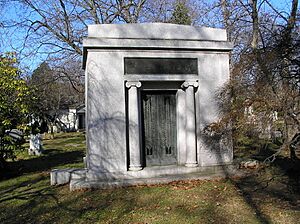Takamine Jōkichi facts for kids
Quick facts for kids
Takamine Jōkichi
|
|
|---|---|
| 高峰 譲吉 | |
 |
|
| Born | November 3, 1854 |
| Died | July 22, 1922 (aged 67) New York, New York, US
|
| Citizenship | Japanese |
| Alma mater | University of Tokyo |
| Known for | isolating and purifying adrenaline, isolating takadiastase |
| Awards | Japan Academy Prize (1912) |
| Scientific career | |
| Fields | Chemistry |
Takamine Jōkichi (高峰 譲吉, November 3, 1854 – July 22, 1922) was a brilliant Japanese chemist. He is famous for being the first person to separate and purify a very important hormone called adrenaline in 1901. He also discovered an important enzyme called takadiastase.
Contents
Early Life and Education
Jōkichi Takamine was born in Takaoka, Toyama in November 1854. His father was a doctor, and his mother came from a family that made sake, a Japanese drink. He grew up in Kanazawa, Ishikawa.
When he was a child, Takamine learned English from a Dutch family in Nagasaki. This is why he always spoke English with a Dutch accent! He studied in Osaka, Kyoto, and Tokyo, graduating from the Tokyo Imperial University in 1879. He then continued his studies in Scotland, at the University of Glasgow and Anderson College, until 1883.
Amazing Discoveries and Career
Working in Japan
In 1883, Takamine returned to Japan. He joined the chemistry part of the new Department of Agriculture and Commerce. Later, he started his own company, the Tokyo Artificial Fertilizer Company.
It was here that he discovered an important enzyme called takadiastase. An enzyme is like a tiny helper molecule that speeds up chemical reactions. Takamine found this enzyme from a special fungus called koji. This fungus is used to make things like soy sauce and miso in Japan. Koji is so important that it's even called a "designated national fungus" in Japan! Takadiastase helps break down starch.
Moving to the United States
In 1884, Takamine traveled to New Orleans for the World Cotton Centennial Exposition. There, he met Caroline Field Hitch, who would later become his wife.
In 1885, he helped set up the Japanese Patent Office. He also started the Tokyo Artificial Fertilizer Company, bringing in a lot of phosphate from the United States. In 1890, he moved to Chicago with his wife and two sons.
Takamine opened his own research lab in New York City. He gave a big pharmaceutical company, Parke-Davis, the special right to make his takadiastase. This was a very smart decision! He quickly became a millionaire. By the early 1900s, he was estimated to be very wealthy.
In 1894, Takamine received a US patent for his "Process of Making Diastatic Enzyme." This was the first patent in the United States for an enzyme from microbes.
In 1901, he made another huge discovery. He was the first to separate and purify the hormone adrenaline from animal glands. Adrenaline became the first effective medicine to help people with asthma breathe better.
Promoting Friendship
In 1904, the Emperor Meiji of Japan gave Takamine a special gift. For the St. Louis World Fair, the Japanese government had built a copy of an old Japanese palace called the "Pine and Maple Palace." This beautiful building was given to Dr. Takamine to thank him for helping build good relationships between Japan and the United States. He moved the palace in pieces to his summer home in upstate New York.
In 1905, Takamine started the Nippon Club in Manhattan. This club helped Japanese people in New York and promoted Japanese culture.
Takamine spent much of his life working to keep good feelings between the US and Japan. In 1912, the mayor of Tokyo and Jokichi Takamine gave a gift of cherry blossom trees to Washington, DC. These trees were planted around the Tidal Basin and are now famous for the yearly National Cherry Blossom Festival.
A photo from 1915 shows Jōkichi Takamine hosting a special dinner for a Japanese diplomat. This shows how important he was in connecting Japan and the US, especially with the gift of the cherry blossom trees.
Personal Life
On August 10, 1887, Takamine married Caroline Field Hitch in New Orleans. They had two sons: Jokichi Takamine, born in Tokyo in 1888, and Ebenezer Takashi Takamine, born in 1889. The family moved to the US in December 1890. Because of his wife's influence, he became a Catholic and kept this faith throughout his life.
Awards and Honors
- In 1899, Takamine received an honorary doctorate from what is now the University of Tokyo.
- On April 18, 1985, the Japan Patent Office chose him as one of Ten Japanese Great Inventors.
See also



